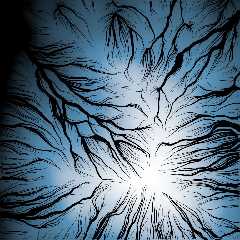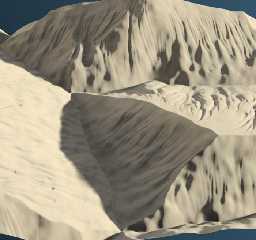 |
 |
|
 |
|
 |
|  |
|  |
|
 |
|
 |
|  |
|  |
|
 |
Sheesh, this image didn't want to compress well at all!
Can anyone guess what I was working toward when I came across this
image? It should be easy to guess. There seems to be a lack of good,
free implementations of it anywhere...
Sam
Post a reply to this message
Attachments:
Download 'ua1.jpg' (166 KB)
Preview of image 'ua1.jpg'

|
 |
|  |
|  |
|
 |
|
 |
|  |
|  |
|
 |
That's beautiful.
I don't know what it's supposed to be, some kind of roots or seaweed maybe?
I'd really like to see the source code I have no idea how you've done it!
--
Tek
http://evilsuperbrain.com
"stbenge" <THI### [at] hotmail com> wrote in message
news:489e1fe2@news.povray.org...
> Sheesh, this image didn't want to compress well at all!
>
> Can anyone guess what I was working toward when I came across this
> image? It should be easy to guess. There seems to be a lack of good,
> free implementations of it anywhere...
>
> Sam
> com> wrote in message
news:489e1fe2@news.povray.org...
> Sheesh, this image didn't want to compress well at all!
>
> Can anyone guess what I was working toward when I came across this
> image? It should be easy to guess. There seems to be a lack of good,
> free implementations of it anywhere...
>
> Sam
>
Post a reply to this message
|
 |
|  |
|  |
|
 |
|
 |
|  |
|  |
|
 |
Tek wrote:
> That's beautiful.
> I don't know what it's supposed to be, some kind of roots or seaweed maybe?
> I'd really like to see the source code I have no idea how you've done it!
Actually, it's the preliminary result of an erosion setup I have going.
The attached image shows what it can do so far. It still needs more work
done to it before it can simulate sharp-edged "Alaska style" erosion.
All I'm really doing is using trace() on a height_field and updating the
vectors to correspond with the surface normal. The objects are cylinders
which grow bigger the longer they are "alive."
Sam
Post a reply to this message
Attachments:
Download 'dunes.jpg' (62 KB)
Preview of image 'dunes.jpg'

|
 |
|  |
|  |
|
 |
|
 |
|  |
|  |
|
 |
"stbenge" <THI### [at] hotmail com> schreef in bericht
news:489e40de@news.povray.org...
>
> Actually, it's the preliminary result of an erosion setup I have going.
> The attached image shows what it can do so far. It still needs more work
> done to it before it can simulate sharp-edged "Alaska style" erosion.
>
> All I'm really doing is using trace() on a height_field and updating the
> vectors to correspond with the surface normal. The objects are cylinders
> which grow bigger the longer they are "alive."
>
Very neat! Shouldn't cones not be more appropriate than cylinders in this
context?
Thomas com> schreef in bericht
news:489e40de@news.povray.org...
>
> Actually, it's the preliminary result of an erosion setup I have going.
> The attached image shows what it can do so far. It still needs more work
> done to it before it can simulate sharp-edged "Alaska style" erosion.
>
> All I'm really doing is using trace() on a height_field and updating the
> vectors to correspond with the surface normal. The objects are cylinders
> which grow bigger the longer they are "alive."
>
Very neat! Shouldn't cones not be more appropriate than cylinders in this
context?
Thomas
Post a reply to this message
|
 |
|  |
|  |
|
 |
|
 |
|  |
|  |
|
 |
Ah of course! That's a really nice effect already but I look forward to
seeing the "Alaska style" results :)
--
Tek
http://evilsuperbrain.com
"stbenge" <THI### [at] hotmail com> wrote in message
news:489e40de@news.povray.org...
> Tek wrote:
>> That's beautiful.
>> I don't know what it's supposed to be, some kind of roots or seaweed
>> maybe?
>> I'd really like to see the source code I have no idea how you've done it!
>
> Actually, it's the preliminary result of an erosion setup I have going.
> The attached image shows what it can do so far. It still needs more work
> done to it before it can simulate sharp-edged "Alaska style" erosion.
>
> All I'm really doing is using trace() on a height_field and updating the
> vectors to correspond with the surface normal. The objects are cylinders
> which grow bigger the longer they are "alive."
>
> Sam
>
>
> com> wrote in message
news:489e40de@news.povray.org...
> Tek wrote:
>> That's beautiful.
>> I don't know what it's supposed to be, some kind of roots or seaweed
>> maybe?
>> I'd really like to see the source code I have no idea how you've done it!
>
> Actually, it's the preliminary result of an erosion setup I have going.
> The attached image shows what it can do so far. It still needs more work
> done to it before it can simulate sharp-edged "Alaska style" erosion.
>
> All I'm really doing is using trace() on a height_field and updating the
> vectors to correspond with the surface normal. The objects are cylinders
> which grow bigger the longer they are "alive."
>
> Sam
>
>
>
Post a reply to this message
|
 |
|  |
|  |
|
 |
|
 |
|  |
|  |
|
 |
stbenge wrote:
> There seems to be a lack of good, free implementations of it
> anywhere...
The basic edition of World Machine is free, although the
output resolution is then restricted to 512x512. Still, could
be enough to get the basic erosion done and then add some
finer details in POV using f_ridge.
Post a reply to this message
|
 |
|  |
|  |
|
 |
|
 |
|  |
|  |
|
 |
Thomas de Groot wrote:
> "stbenge" <THI### [at] hotmail com> schreef in bericht
>> All I'm really doing is using trace() on a height_field and updating the
>> vectors to correspond with the surface normal. The objects are cylinders
>> which grow bigger the longer they are "alive."
>
> Very neat! Shouldn't cones not be more appropriate than cylinders in this
> context?
Yes, of course, but I wanted to test the proof-of-concept first, and
worry about cone-sphere connection issues later. As it is, this project
isn't working out too well...
Sam com> schreef in bericht
>> All I'm really doing is using trace() on a height_field and updating the
>> vectors to correspond with the surface normal. The objects are cylinders
>> which grow bigger the longer they are "alive."
>
> Very neat! Shouldn't cones not be more appropriate than cylinders in this
> context?
Yes, of course, but I wanted to test the proof-of-concept first, and
worry about cone-sphere connection issues later. As it is, this project
isn't working out too well...
Sam
Post a reply to this message
|
 |
|  |
|  |
|
 |
|
 |
|  |
|  |
|
 |
Tek wrote:
> Ah of course! That's a really nice effect already but I look forward to
> seeing the "Alaska style" results :)
Well, you might be looking forward for a long time, because this
technique isn't working out! All I've managed to do is scratch the
surface down the sides of the height_field. Maybe I should post the
source so other people can look at it. A free, fully-automated erosion
setup producing 16-bit gray scale height maps... that would be nice.
Sam
Post a reply to this message
|
 |
|  |
|  |
|
 |
|
 |
|  |
|  |
|
 |
Christian Froeschlin wrote:
> stbenge wrote:
>
>> There seems to be a lack of good, free implementations of it
>> anywhere...
>
> The basic edition of World Machine is free, although the
> output resolution is then restricted to 512x512. Still, could
> be enough to get the basic erosion done and then add some
> finer details in POV using f_ridge.
That's a good idea, especially since it seems POV 3.7b handles 16-bit
gray scale images better. I discovered yesterday that you can
encapsulate them inside pigment statements without them turning back
into black-green green-red ramp wave nightmares. It makes the
possibilities open up ;)
Sam
Post a reply to this message
|
 |
|  |
|  |
|
 |
|
 |
|  |
|  |
|
 |
stbenge <THI### [at] hotmail com> wrote:
> Tek wrote:
> > Ah of course! That's a really nice effect already but I look forward to
> > seeing the "Alaska style" results :)
>
> Well, you might be looking forward for a long time, because this
> technique isn't working out! All I've managed to do is scratch the
> surface down the sides of the height_field. Maybe I should post the
> source so other people can look at it. A free, fully-automated erosion
> setup producing 16-bit gray scale height maps... that would be nice.
>
> Sam
Suddenly I am reminded of playing with the 'flow' command in hf_lab in an
attempt to build eroded height fields... I had limited success. I am very
interested in your technique(s), though. I've wondered whether a decent
erosion routine could be made into functions for use with isosurface based
landscapes.
-Reactor com> wrote:
> Tek wrote:
> > Ah of course! That's a really nice effect already but I look forward to
> > seeing the "Alaska style" results :)
>
> Well, you might be looking forward for a long time, because this
> technique isn't working out! All I've managed to do is scratch the
> surface down the sides of the height_field. Maybe I should post the
> source so other people can look at it. A free, fully-automated erosion
> setup producing 16-bit gray scale height maps... that would be nice.
>
> Sam
Suddenly I am reminded of playing with the 'flow' command in hf_lab in an
attempt to build eroded height fields... I had limited success. I am very
interested in your technique(s), though. I've wondered whether a decent
erosion routine could be made into functions for use with isosurface based
landscapes.
-Reactor
Post a reply to this message
|
 |
|  |
|  |
|
 |
|
 |
|  |




![]()